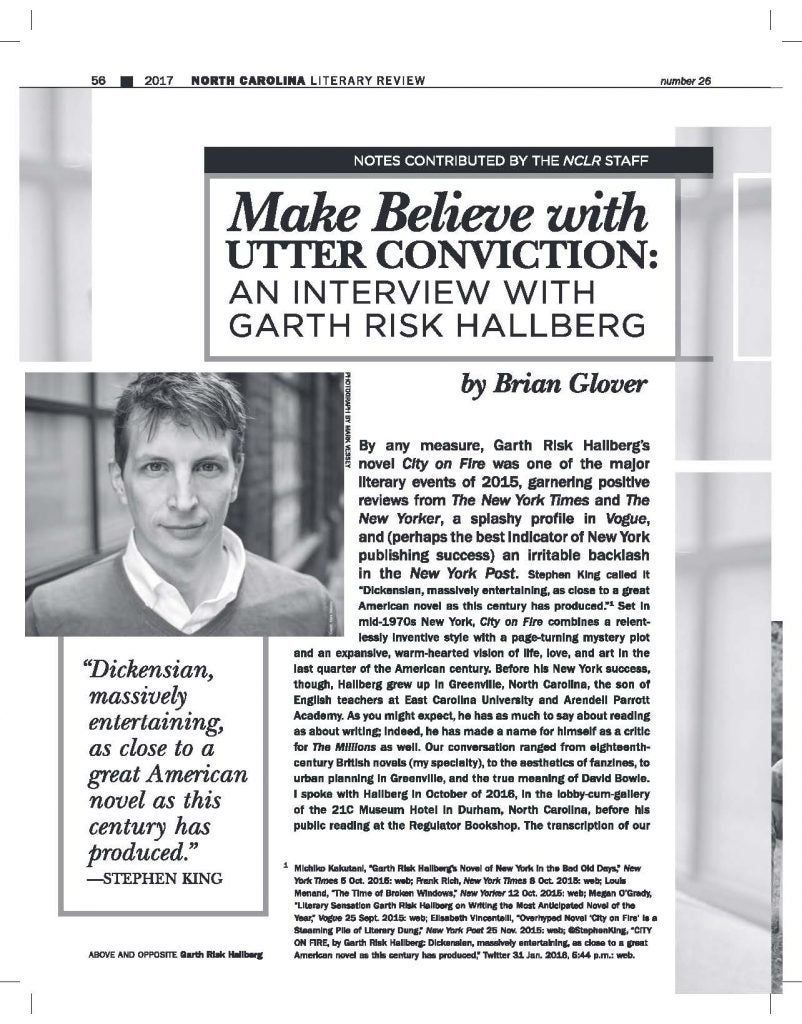Friday from the Archives: “Make Believe with Utter Conviction: An Interview With Garth Risk Hallberg” by Brian Glover from NCLR Issue 24 (2017)
It’s always an exciting day when one of our own gets the Hollywood treatment. Apple+ optioned Garth Risk Hallberg’s 2015 debut novel City on Fire as a limited series, playing now through June.
Hallberg recently talked with NCLR Senior Assistant Editor Christy Alexander Hallberg — full disclosure: his stepmom — for her podcast “Rock is Lit,” which focuses on literature with rock influences on characters and storylines.
For NCLR, Brian Glover interviewed Hallberg during his novel book tour in 2015. Glover wrote, “By any measure, Garth Risk Hallberg’s novel City on Fire was one of the major literary events of 2015, garnering positive reviews from The New York Times and The New Yorker, a splashy profile in Vogue, and (perhaps the best indicator of New York publishing success) an irritable backlash in the New York Post.” Their conversation roams from literary influences to growing up in Greenville, NC, to how important the book design was.
Critical reviews of the television series make much of the fact that acclaimed showrunners Schwartz and Savage changed the time period of the show to 2003 from the original 1973 of the novel. Hallberg told Glover the ’70s were a deliberate choice for his story. He said, “I came to feel somewhere in the germinal stages of this book, before it really became a solid idea, that there was some kind of inflection point in
the early to mid-1970s. That something came to an end, and that something was born, and that the world that we live in now is part of what was being born then; that we are more the heirs of 1973, and the oil shock, and Watergate, and the kidnapping of Patty Hearst, than we are the heirs of the Port Huron statement.”
Hallberg follows that with “And similarly, I have come to feel – I don’t know if I’ll feel this way in thirty years – but I’ve come to feel that – as much as it may be parochial to imagine that the age of global terrorism started in 2001, because of course it didn’t – that nonetheless, 2001 marked a very significant historical inflection point, and in a lot of ways everything really did change – not just here, but globally.”
It’s not common for two creative writing professors to discuss the technical details of book design, at least, in public. Glover inquires about Hallberg’s use of “interstitials” in City on Fire and Hallberg essentially laughs at the memory. He said, “This could be the last book that is ever written, as in, the Book would
have died and I’ll be here thirty years later trying to finish this damned book. Or, it’ll be just after the last book ever written was written. And so, there was a part of me that longed, even if it wasn’t going to be
publishable, for it to be something for everyone who really loves books – who loves reading them, but loves their headbands and loves their rough fronts or smooth fronts, their density, all of the stuff that an
eBook doesn’t have.” Thankfully, Books continue, and we look forward to reading Hallberg’s next one, whenever that may be.
Read the whole essay in the 2017 issue via Gale Cengage (at NC Live) or you can still order for your collection. Order the book at bookshop.org.
